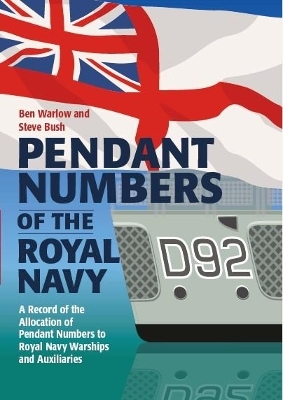
Pendant Numbers of the Royal Navy
A Record of the Allocation of Pendant Numbers to Royal Navy Warships and Auxiliaries
Seiten
2021
Seaforth Publishing (Verlag)
978-1-5267-9378-2 (ISBN)
Seaforth Publishing (Verlag)
978-1-5267-9378-2 (ISBN)
The first complete book on RN pendant numbers.
Pendant (or pennant) numbers have been used by individual ships of the Royal Navy for purposes of identification for more than 100 years. They were also used in all the navies of the British Empire so that ships could be easily transferred from one navy to another without changing her number. They offer the simplest and clearest way to identify a ship, but until now there has been little in the way of consistent and accurate information, and certainly no single location where you can look up or research complete pendant numbers.
The book is designed as an easy-to-use reference work and as such is, in the main, composed of alpha-numeric listings to enable the user to find and identify warships by reference to ship name and to identify specific pendant numbers assigned to that name; or by pendant number to identify specific vessels assigned that number at various times.
It begins with an introduction and a brief history of visual signalling used by the Royal Navy before industrialisation, and explains how the large numbers of identical ships being built brought about the need to identify specific ships within fleets to aid signalling and tactical deployment. There follow chapters covering the pendant numbers of the surface fleet and submarines (which stopped using them once boats began to spend so little time on the surface), and then pedant numbers by ship name.
A significant chapter lists the pendant numbers assigned to the British Pacific Fleet during the Pacific campaign of WWII together with an explanation of why numbers were assigned, and an examination of missing 'A' series pendants known to have been carried by some vessels during the conflict. The BPF numbers have only recently come to light and there is still much that is not known but this section provides the most comprehensive study of available data at this time. There is also an appendix covering deck letters assigned to aviation capable ships.
This is a genuinely new and significant reference book and is destined to become a major new aid for Royal Navy warship and auxiliary identification.
Pendant (or pennant) numbers have been used by individual ships of the Royal Navy for purposes of identification for more than 100 years. They were also used in all the navies of the British Empire so that ships could be easily transferred from one navy to another without changing her number. They offer the simplest and clearest way to identify a ship, but until now there has been little in the way of consistent and accurate information, and certainly no single location where you can look up or research complete pendant numbers.
The book is designed as an easy-to-use reference work and as such is, in the main, composed of alpha-numeric listings to enable the user to find and identify warships by reference to ship name and to identify specific pendant numbers assigned to that name; or by pendant number to identify specific vessels assigned that number at various times.
It begins with an introduction and a brief history of visual signalling used by the Royal Navy before industrialisation, and explains how the large numbers of identical ships being built brought about the need to identify specific ships within fleets to aid signalling and tactical deployment. There follow chapters covering the pendant numbers of the surface fleet and submarines (which stopped using them once boats began to spend so little time on the surface), and then pedant numbers by ship name.
A significant chapter lists the pendant numbers assigned to the British Pacific Fleet during the Pacific campaign of WWII together with an explanation of why numbers were assigned, and an examination of missing 'A' series pendants known to have been carried by some vessels during the conflict. The BPF numbers have only recently come to light and there is still much that is not known but this section provides the most comprehensive study of available data at this time. There is also an appendix covering deck letters assigned to aviation capable ships.
This is a genuinely new and significant reference book and is destined to become a major new aid for Royal Navy warship and auxiliary identification.
STEVE BUSH joined the Royal Navy in 1978 and saw several operational deployments to the Gulf, including the 1991 Gulf War. On leaving the navy in 2000 he joined Maritime Books, editing their in-house publications, while he took up the position of Editor of _Warship World_ and _Warship World Pictorial Review_ magazines in 2003/. He is the author of a number of books including _British Warships and Auxiliaries._ BEN WARLOW was a naval officer in the Royal Navy for more than 40 years. He is a consultant editor to _Warship World_ and the author of more than 20 books on naval history, including the highly esteemed _Ships of the Royal Navy_.
| Erscheinungsdatum | 06.03.2022 |
|---|---|
| Zusatzinfo | 32 black and white illustrations |
| Verlagsort | Barnsley |
| Sprache | englisch |
| Maße | 156 x 234 mm |
| Themenwelt | Natur / Technik ► Fahrzeuge / Flugzeuge / Schiffe ► Militärfahrzeuge / -flugzeuge / -schiffe |
| Natur / Technik ► Fahrzeuge / Flugzeuge / Schiffe ► Schiffe | |
| Geisteswissenschaften ► Geschichte ► Regional- / Ländergeschichte | |
| Geschichte ► Teilgebiete der Geschichte ► Militärgeschichte | |
| Sozialwissenschaften ► Politik / Verwaltung | |
| ISBN-10 | 1-5267-9378-4 / 1526793784 |
| ISBN-13 | 978-1-5267-9378-2 / 9781526793782 |
| Zustand | Neuware |
| Haben Sie eine Frage zum Produkt? |
Mehr entdecken
aus dem Bereich
aus dem Bereich
von der Machtergreifung bis zur Gründung der Vereinten Nationen
Buch | Softcover (2023)
Motorbuch Verlag
CHF 38,90


